
|
|

May 30, 2008
The Big Trip 2007, part V: Bozeman, Montana
It's become an annual tradition here at Tower Site of the Week - load up the tape decks and the DVD recorders and the cameras, line up a bunch of station tours, gather a few friends, and hit the road for as much as two weeks of in-depth exploration of the radio and TV environment in some scenic part of this great nation of ours. Then we come home and share it all with you, in pictures here on fybush.com and in audio (of legal IDs) over at our sister site, tophour.com.
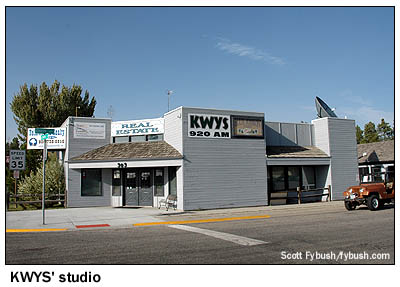
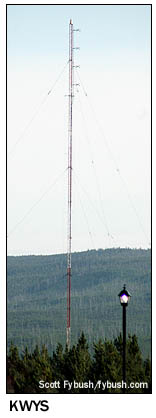 "Big Trip 2007"
covered parts of Utah, Wyoming, Idaho, Montana, Washington and
Oregon over two weeks in late August and early September.
"Big Trip 2007"
covered parts of Utah, Wyoming, Idaho, Montana, Washington and
Oregon over two weeks in late August and early September.
Day Four - Sunday, August 26, 2007
This fifth installment of our recap finds us, at last, saying goodbye to the Salt Lake City metropolis, headed north up I-15 past Pocatello and Idaho Falls (to which we'd return at the end of the trip) and then up US 20 and across the border into the one and only new state of this trip: Montana.
As the road wends its way up through the mountains to the state line, there's visible smoke in the air from the wildfires that have been plaguing the region (and will eventually force a small change in the later part of our itinerary) - and an audible effect of the fires, too: two FMs that share a mountaintop site near the Idaho/Montana line, KEZQ (92.9 West Yellowstone MT) and KWYS-FM (102.9 Island Park ID) are off the air, apparently as the result of fire damage. Indeed, this part of the trip brings with it one of the quietest radio dials we'll hear at any point on our travels, as the "scan" on the radio just keeps cycling around without hitting much of anything.
Eventually, the AM side of the scan comes to a stop on 920 as we pull into West Yellowstone, the tacky strip of motels and gift shops at the edge of Yellowstone National Park. The KWYS (920 West Yellowstone) tower sits just outside the park gate, with what are presumably an old set of FM bays mounted on the side; the studios are in with a real estate office on the north side of town, which we pass as we head north on US 191 for our stop this night in Bozeman, Montana.

|
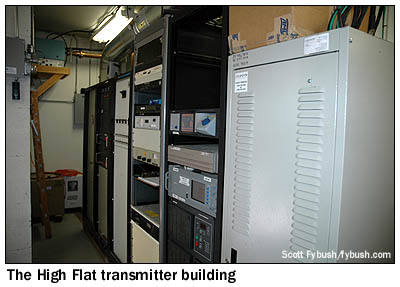
|
Day Five - Monday, August 27, 2007
It's pretty safe to say that we knew next to nothing about Montana broadcasting when we set off on this trip. As is usually the case when we have lots of ground to cover and not a lot of time in which to cover it, we didn't expend a lot of energy on setting up station tours before the trip, so it was a good thing we had some leeway in our Monday schedule as Bozeman turned from "quick drive-by and on to the next town" into "in-depth visit."
For that, we can thank a hotel-room Google search on Sunday night in search of information about the KBOZ stations in Bozeman, a cluster of two AMs, three FMs and a cable TV station that all brand as "KBOZ." In the absence of a full-fledged website for the stations themselves, our search led us to the website of an engineering firm called "Montanavision," and as we perused Jim Bender's wonderful collection of facility photos from across the Big Sky State, what did we find, among a page of photos from NAB 2007, but a picture of me chatting with Clark Novak at the Omnia/Telos/Axia booth!
So Monday morning's first call was to Jim, who was delighted to find out there were tower hunters in town - and who promptly invited us to come see the site where he was working. The High Flat Electronic Site is about a dozen miles west of Bozeman, and it's home to two full-power FMs, Yellowstone Public Radio's KEMC (102.1 Bozeman) and Orion Media's KKQX (105.7 Manhattan), which share the 200' tower near the center of the picture above. (KEMC's five bays are hard to spot at the top of the tower; KKQX's four-bay antenna is clearly visible below.)
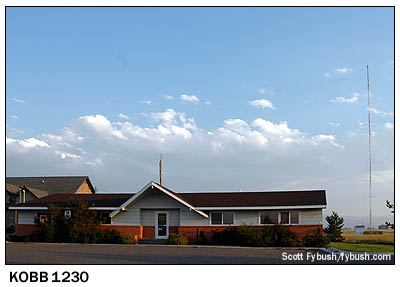
|
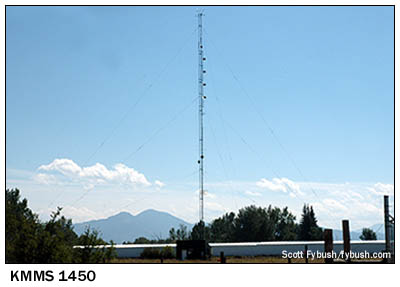
|
Visiting with Jim fills us in on a lot of the history in the market that we'd have missed otherwise, particularly where the first two AM signals in town are concerned. KOBB (1230 Bozeman) dates back to 1946, when it signed on as KBMN from a site on North 7th Avenue on the north side of Bozeman. Seven years earlier, in 1939, KRBM (1450 Bozeman) had come on the air as the city's first station. Later known as KXLQ (part of the Portland, Oregon-based KXL network), then as KXXL, by 1992 the station was KMMS, operating from a studio and transmitter site at 1450 W. Kagy Boulevard on the south side of town. That's when KBMN's tower on North 7th was demolished, and the 1230 transmitter moved to the 1450 site, becoming the first diplexed AM in Montana.
In 2000, KMMS left the Kagy Boulevard site and moved to a new tower on the north side of town, just a few hundred yards east of the original KBMN site. (How many AM towers have passed from one station to a completely different one in the course of their existence? Not many, I'd bet.) The old KBMN building still stands, not far from the I-90 on-ramps from North 7th, and is used as a small casino; the old KMMS studio building on Kagy Boulevard is now a daycare center, with the transmitter for KOBB relegated to a small utility building out back. (The FM bays on the tower belong to Catholic radio KOFK-LP on 98.3.)
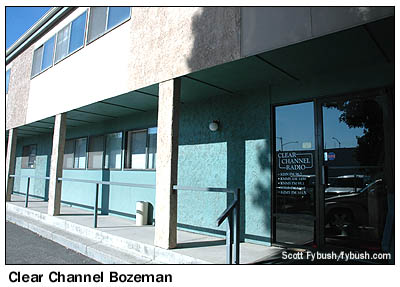
|
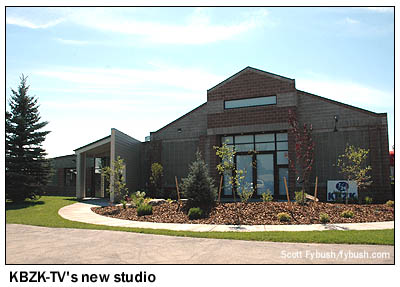
|
KMMS does news-talk as part of the Clear Channel cluster in town, which also includes classic hits "Moose" KMMS-FM (95.1 Bozeman), top 40 "Kiss" KISN (96.7 Belgrade), "XL Country" KXLT (100.7 Livingston) and hot AC "My" KZMY (103.5 Bozeman) - and which would be sold to Gap Broadcasting a few months after our visit. I think that's an auxiliary antenna for KMMS-FM on the KMMS(AM) tower; there's an LPTV here, too. The Clear Channel studios are in a nondescript office building a block north of Bozeman's scenic Main Street, which is undergoing massive repaving while we're in town.

Continuing south from Kagy Boulevard, pavement turns to gravel and dirt as we head out of town about two miles to the biggest - and most recent - AM voice in Bozeman.
Bill Reier put KBOZ (1090 Bozeman) on the air in 1975 from this widely-spaced five-tower array, using 5 kW day and night, DA-N. Reier sold KBOZ and sister station KBOZ-FM (93.7 Bozeman) to Larry Wilson in 1986, and perhaps you've heard of the new company Wilson founded to own the stations: Citadel Broadcasting.
As Citadel's attention turned to much bigger markets a decade later, it sold the Bozeman stations - by then, KBOZ (1090), KATH (93.7 Livingston) and KPKX (97.5 Livingston) - back to Reier, who combined them with the two stations he'd acquired in the meantime, KZLO (later KOBB) on 1230 and KZLO-FM (99.9 Bozeman).
Luckily for Reier, Jim Bender and Montanavision were by then handling engineering for all five stations anyway, and Jim takes particular (and well-justified) pride in the broadcast facility he's built and maintained for Reier at the "Radio Ranch" down on Johnson Road.

|

|
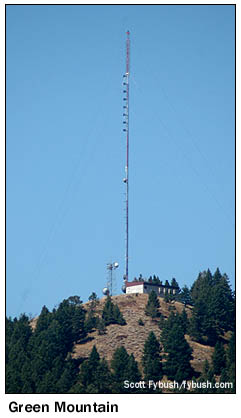
|
At the moment, KBOZ(AM) and all three FMs - "KBOZ oldies" KOBB-FM (93.7), "KBOZ rock" KOZB (97.5) and "KBOZ country" KBOZ-FM (99.9) - transmit from Johnson Road, while standards "KBOZ Lite" KOBB (1230) uses the Kagy Boulevard site to the north. All three FMs use the Johnson Road site under Special Temporary Authority, having moved down here from separate mountaintop sites on Story Hill (93.7/99.9) and Bozeman Pass (97.5) in 2006.
All three stations have CPs to move to a new tower up at Green Mountain, another one of the mountaintop sites strung out along I-90 east of Bozeman. That site (shown above at right, in a long view from the side of I-90) is currently home to the Clear Channel/Gap FMs, as well as most of Bozeman's TV stations - ABC affiliate KWYB-LP (Channel 28), NBC affiliate K42BZ (Channel 42)/K34FI-D (Channel 34), Fox affiliate KBTZ-LP (Channel 32), the University of Montana's KUSM-TV (Channel 9/DT 8) and CBS affiliate KBZK (Channel 7/DT 13).
(A few words here about the oddity that is Montana TV: in these small markets, there are a lot of LPTVs and multi-city simulcasts. KWYB-LP is co-owned with KWYB-TV 18 in Butte, 80 miles to the west, though it runs its own local ads and a bit of local news. The "Fox Montana" stations, including KBTZ-LP and Butte's KBTZ-TV 24, are operated in tandem with the ABC outlets. K42BZ and digital K34FI are simulcasts of Butte's KTVM, which maintains newsrooms in both cities and identifies as "NBC 6 & 42"; its weekend and morning news, in turn, comes from Missoula's KECI-TV. KBZK is part of the Montana Television Network, which has CBS affiliates across the state, headquartered at KTVQ in Billings. Weekend and weekday morning newscasts come from Billings, while weekday evening newscasts have shifted from Butte's KXLF to a new studio, shown above, here in Bozeman. Over the last few years, KBZK has transitioned from Fox, under former calls KCTZ, to a KXLF satellite, to a new status as a local Bozeman outlet beginning just after our visit. Why go local? In addition to being home to the University of Montana, Bozeman is increasingly the hub of a very wealthy resort population. All those ranches Ted Turner's bought in the area? Those are largely in the greater Bozeman area, and there's some resentment among longtime residents of all the "outsiders" driving up real estate prices in the region.)

|
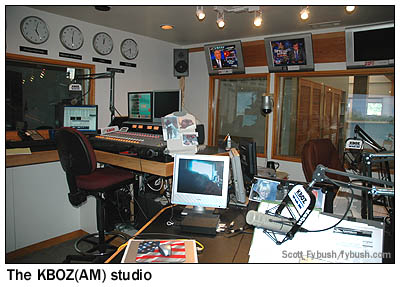
|
So where were we? Ah yes - at KBOZ, where the "Radio Ranch" on Johnson Road is now a darned fine broadcast facility for a market this size. Walking in the front door, we're greeted by sales and management offices, and after being introduced to Mr. Reier, we head for the back end of the building, where a row of studios surrounds a very nice rack room that was once home to the KBOZ(AM) transmitter.
Thanks to the heavy use of automation and satellite feeds, most of these studios are unoccupied when we visit, but all the automated programming on KOBB(AM) and the FMs is more than made up by the very heavy local content in the morning on KBOZ(AM), simulcast on KOBB-FM and "KBOZ TV." Co-hosts Dave Visscher and Dean Alexander are Bozeman institutions, and it's fun to tune in on cable TV to watch the show come together, complete with mystery newsman "Mister Info," who's only seen from behind, as well as the producer of the TV simulcast chiming in from her post in the control room. Jim rebuilt this studio in 2004, and he deserves to be proud of the way it turned out.
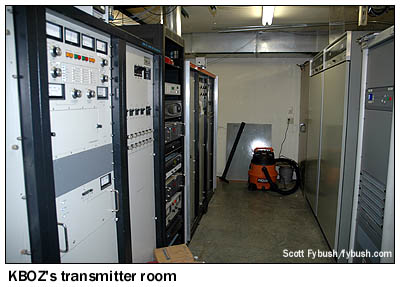
|
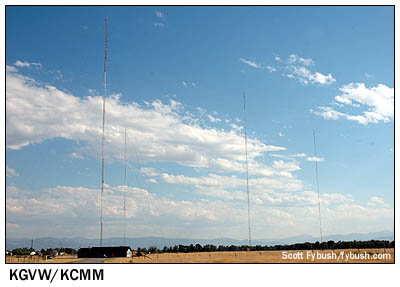
|
As the old transmitter room within the building was rebuilt to become today's rack room, the AM transmitter was moved out to the FM transmitter building, a smaller structure near the AM array. That's it on the right in the photo above, across from the row of FM transmitters - the 1975-vintage Gates MW5, now a backup, and the new Harris DAX to its right.
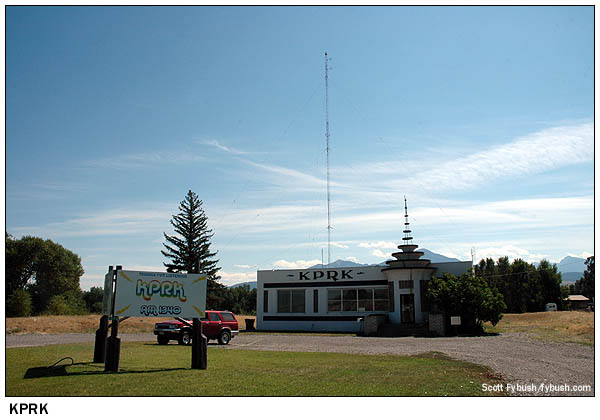 Two
more AM sites finish out our visit to Bozeman and vicinity: 20
miles or so west of Bozeman along I-90 sits the small town of
Belgrade, and it's there, just off the highway, that we find
the studio and four towers of religious KGVW (640) and KCMM (99.1).
KGVW uses 10 kW by day from two of these towers (the center tower
and the dogleg tower), 1 kW at night from the three in-line towers;
KCMM is a 20 kW C3 facility from the tower right behind the studios.
Two
more AM sites finish out our visit to Bozeman and vicinity: 20
miles or so west of Bozeman along I-90 sits the small town of
Belgrade, and it's there, just off the highway, that we find
the studio and four towers of religious KGVW (640) and KCMM (99.1).
KGVW uses 10 kW by day from two of these towers (the center tower
and the dogleg tower), 1 kW at night from the three in-line towers;
KCMM is a 20 kW C3 facility from the tower right behind the studios.
But before we get to Belgrade, our schedule stretches once more to include an unplanned diversion 25 miles east of Bozeman to the small town of Livingston.
We'd seen postcards of KPRK (1340 Livingston), but had somehow failed to process the fact that this very distinctive building was still standing, and was so close to Bozeman. (Yes, there's a nominal 75 MPH speed limit on Montana's interstates, but it's honored mainly in the breach.)
But...wow! This building is actually listed on the National Register of Historic Places, and if you look carefully to the right of the front door, you can just see the plaque that informs us that Missoula architect William Fox designed this building, complete with the "stylized radio tower" above the front door, in 1946. "Montana's Model Station," as the postcards proclaimed, hasn't changed much in the six decades since; about the only reminder that we're in the early 21st century, aside from the truck in the parking lot, is the two-bay antenna on the tower for translator K254AL (98.7), relaying Bozeman's KXLT, a sister station under Clear Channel and now under Gap. The KPRK calls, incidentally, stand for "PaRK," a reference to Park County, where Livingston is located, and thus to Yellowstone National Park, an hour's drive to the south.
By the time we're done with all our tours (and lunch with Jim and his friends from Yellowstone Public Radio), we're leaving Bozeman several hours later than we'd planned - but with no regrets, because we've turned a series of drive-by photos into a nice look at a really nifty small market. It turns out we still had plenty of time to get a look at the stations of Butte on Monday evening, which we'll share with you next week in part six of our retrospective. And don't forget to join us over at sister site Tophour.com on Wednesday for a whole bunch of IDs from Bozeman!
Tower Site Calendar 2008 is almost sold out! Visit the Fybush.com Store now and get your calendar now!
- Previous Site of the Week: Big Trip 2007 Part IV - East to Park City, Utah and Evanston, Wyoming
- Next Week: Big Trip 2007 Part VI - Butte, Montana
- Site of the Week INDEX!
- How can you help support Site of the Week? Click here!
- Submit your suggestions for a future Site of the Week!
